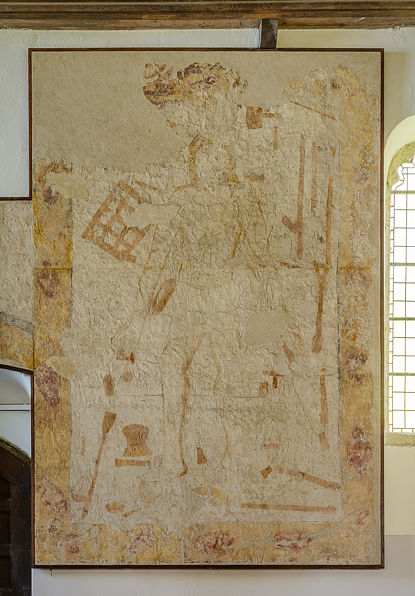Poundstock, Cornwall (†Truro) C.15
Warning to Sabbath Breakers


The painting was remounted on fresh plaster in 1970, and now appears framed on the north wall alongside a ‘Seven Deadly Sins’ shown below. It is shown at the right with an alternating image of a copy made when the painting was first revealed, which is shown in the church (hover over the image to stop the animation).
Even more than Breage, the Poundstock Warning to Sabbath Breakers makes its meaning graphically clear. The two-handled saw cutting across Christ’s legs is very prominent, and there seems to be an emphasis on implements that cut, slice or abrade. There is a whip or knotted knout at the upper right – perhaps something with an agricultural or industrial use, or, quite possibly, an import from the Instruments of the Passion¹. Gouts of blood also feature strongly.
As at St Just-in-Penwith there is, unusually, a balance, signifying, presumably, commercial activities of various kinds, and, also as at St Just, the central (and in this case apparently naked) figure of Christ is not well drawn. At Poundstock the painter has evidently had problems with Christ’s right leg, but his intention, i.e. to show the two-handled saw passing between the legs, comes through clearly enough.
The village and church of Poundstock have a fascinating Reformation history. At the introduction of the English Prayer Book in 1549, the people of Cornwall, many of whom knew no English, rose in arms at the imposition of this foreign innovation, and Simon Morton, vicar of Poundstock, was prominent among them. An 18th century account of his fate claims that “One Simon Morton, vicar of the parish of Poundstock, was hanged at the market house in the town of Stratton for high treason. He was hanged upon the 13th day of October 1549 and buried the 18th day of the same month. The cross or pedestal whereon he hung is wanting, but the stone in which it was fixed is still to be seen.” No account of Morton’s trial has come down to us, but in 1550 Poundstock certainly had a new vicar, Roger Harward. Despite his description by a Puritan source in 1586 as “a mass man, a suspicious liver” he must have been more tractable than Morton, since he remained in office for nearly 40 years.²

Also at Poundstock is this very faded and fragmentary painting of the Seven Deadly Sins.
You can see a 360° panorama of the interior of the church here.
¹ There is more discussion of the significance of this importation on the page for the Warning to Sabbath Breakers at Hesset in Suffolk.
² This information comes from the excellent guide book published by the Parochial Church Council of Poundstock and available in the church.
† in page heading = Diocese
Photos: © Roy Reed 2017